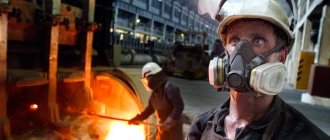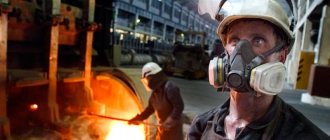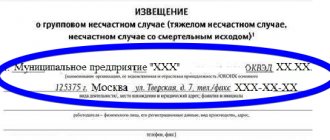Such an area as the investigation and recording of occupational diseases is regulated by Government Decree No. 967 of the Russian Federation of December 15, 2000 (as amended). According to it, there are 2 types of occupational diseases - acute and chronic.
The category of strictly disease includes cases of disability that arose as a result of a short-term (as a rule, we are talking about one work shift) influence on an employee of some harmful production factor or a combination of them.
A chronic disease occurs as a result of prolonged and constant exposure to a harmful production factor and implies loss of ability to work for a long period or forever.
Varieties of occupational diseases are determined by the etiological factor underlying their formation. Their diagnosis and classification is carried out on the basis of the List of Occupational Diseases, which is approved by Order of the Ministry of Health and Social Development of Russia dated April 27, 2012 N 417
What occupational diseases are subject to investigation and recording?
Occupational diseases that arise as a result of harmful production factors when employees perform their job duties on the instructions of an entrepreneur or company are subject to investigation and recording.
In this case, the following persons fall into the category of “employees”:
- Employees performing work on the basis of an employment or civil contract.
- Students and students of higher, secondary and primary educational institutions who undergo internships under an employment contract.
- Prisoners involved in performing labor work.
- Other persons performing various types of work on behalf of a company or individual enterprise.
Procedure for diagnosing and informing about acute occupational diseases
Regulatory documentation - Regulations on the investigation and recording of occupational diseases and Instructions on the procedure for its application - provides the following algorithm of actions:
- Establishing a preliminary diagnosis in any medical institution where the patient has applied.
- A notification from the territorial body of Rospotrebnadzor and the employer is sent within 24 hours and is duplicated simultaneously by telephone, email and other available contacts. The notice is drawn up for each patient individually.
- In the event of the death of an employee caused by acute occupational diseases, the forensic medical examination must immediately notify Rospotrebnadzor.
Upon receipt of a notification from the Rosportebnadzor medical institution:
- Begins to investigate the circumstances that led to the disease.
- Forms a sanitary and hygienic description of the patient’s working conditions and sends it to the health care institution to which the employee is attached, or in accordance with his place of residence.
- Notifies the labor inspectorate in whose jurisdiction the employer is located.
The task of the medical institution that has established the final diagnosis of the disease is to send a notice within 3 days with the final diagnosis, as well as indicating the suspected causes that provoked the disease:
- to Rospotrebnadzor
- organization or individual entrepreneur
- to the insurance company
- to the medical institution that referred the patient.
The day on which the final diagnosis was made is considered the date the disease was established.
Investigation materials of occupational diseases, their storage periods
The commission's conclusions are reflected in a special act. Its applications include:
- message from a medical institution;
- sanitary and hygienic characteristics of working conditions;
- doctors' report indicating the diagnosis;
- extracts from the outpatient card;
- order to create a commission indicating period of investigation of occupational disease;
Download the order form - certificates of completion of training and instructions on labor protection;
- protocols of surveys of employees and managers;
- results of tests, measurements, experiments;
- opinions of independent experts;
- information on the availability and types of PPE (personal protective equipment);
- copies of previously received instructions by the employer regarding safety violations, etc.
The list of applications has been left open to ensure as complete an assessment as possible. Following the procedure for investigating occupational diseases , the commission consistently reflects all the factors that influenced the employee.
The materials are stitched together into a file, described and transferred to the organization’s archives. The second copy of the act with attachments is sent to the territorial sanitary and epidemiological service. The shelf life is determined by clause 33 of Regulation No. 967 - 75 years.
The investigation of occupational diseases at work is aimed at identifying the causes of the current situation and eliminating them. Following the instructions guarantees a complete reflection of the circumstances, as well as an accurate determination of the guilt of both the employer and the employee. The participation of representatives of several structures in the procedure ensures maximum objectivity of the conclusions.
Procedure for diagnosing and informing about chronic occupational diseases
Regulatory documentation - Regulations on the investigation and recording of occupational diseases and Instructions on the procedure for its application - provides the following algorithm of actions:
- The medical institution that established the preliminary diagnosis informs Rospotrebnadzor in the appropriate form. He, in turn, is obliged to receive a copy of the employee’s work book, the results of a preliminary medical examination and, if any, periodic examinations for the maximum possible period of work, as well as information about the patient’s previously diagnosed occupational disease. Based on the documents received, a sanitary and hygienic description of the employee’s working conditions is compiled, which Rospotrebnadzor sends to the health care institution. All this is carried out within 2 weeks from the moment Rospotrebnadzor receives the notification.
The medical institution where the preliminary diagnosis was made must refer the patient to the licensed Rospotrebnadzor for examination within 1 month.
Center for Occupational Pathology:
- Makes a final diagnosis
- Issues a medical report
- Within 3 days, Rospotrebnadzor, the insurance company, the employer, as well as the medical institution that referred the patient for examination will notify about it.
The employer at the last place of work receives a notification - even if the disease arose as a result of exposure to harmful factors during work activities at different production sites.
A medical report on an occupational disease is obtained by:
- Sick
- Insurer
- The medical institution that referred the patient for examination.
When is an acute or chronic disease diagnosed again?
The rules do not exclude the possibility of adjusting the medical opinion. The justification is the results of additional diagnostics and expert studies. This approach fully takes into account the main objectives of conducting an investigation of an occupational disease .
The most complex cases are referred to the pathology center, created on the basis of the Ministry of Health of the Russian Federation. Participants in the procedure are notified of all changes within up to 7 days (clause 17 of Regulation No. 967).
Procedure for forming a commission to investigate occupational diseases
The investigation of occupational diseases is carried out by a special commission, which is formed on the basis of an order from the employer. The employer is obliged to issue an appropriate order within ten days from the date of receipt of notification of the final diagnosis.
The commission consists of 5 people, including:
- Representative from the organization or individual entrepreneur.
- A labor protection specialist or a person performing his functions (must have completed labor protection training).
- Representative of a medical institution.
- An employee representative is a person from a trade union or other body vested with appropriate powers by employees.
- A representative of Rospotrebnadzor - he is also the head of the commission.
If an acute occupational disease was diagnosed in an employee sent to another organization to perform certain work, the investigation takes place where the incident that caused the disease actually occurred. Then the employer’s side in the commission is represented by an employee of the organization that referred the patient.
If we are talking about part-time work, then investigation and accounting are also carried out at the place where the work is actually carried out.
When a chronic occupational disease occurs, an investigation is carried out at the last facility where the patient came into contact with harmful production factors.
As for the patient himself, he or his legal representative can take part in the investigation of his disease.
If we are talking about the liquidation of an organization, the precedent of an occupational disease is investigated by a commission formed by order of Rospotrebnadzor. In such situations, the commission is composed of representatives of Rospotrebnadzor, a medical institution, an insurer and an employee (trade union or other body). Other persons may be involved as necessary.
What are the main objectives of an investigation into an occupational disease?
Ensuring normal working conditions is recognized as the basic principle of regulation in the field of labor law. The responsibility to investigate occupational diseases is assigned to the employer (Articles 210, 212, 227 of the Labor Code of the Russian Federation). A comprehensive assessment of the factors that caused deterioration in health allows:
- improve the security system;
- carry out effective prevention;
- promptly identify violations of labor protection requirements;
- adjust the list of personal protective equipment.
Compliance with the procedure for investigating occupational diseases is recognized as a mandatory condition for the appointment of benefits and insurance payments (Article 15 of the Law “On Compulsory Social Insurance against Industrial Accidents and Occupational Diseases” dated July 24, 1998 No. 125-FZ). The victim has the right to contact the FSS of the Russian Federation only after receiving the corresponding act.
Algorithm for investigating circumstances leading to occupational disease
The regulation on the investigation and recording of occupational diseases obliges the employer to take the following actions:
- Provide access to any materials containing information about working conditions in a given workplace.
- Carry out all necessary research - examinations, laboratory and instrumental measurements and analyzes, etc. - which members of the commission deem necessary to clarify the circumstances of the occurrence of the disease. These procedures are paid for from the employer's funds.
- Keep records and store all documents related to the investigation.
Also, during the investigation, the commission has the right to interview all persons who can clarify the circumstances that led to the occurrence of occupational diseases - the victim himself, his colleagues, employer, persons through whose fault the sanitary and epidemiological rules were violated, etc.
The duty of the commission is to establish the circumstances and causes that led to the occupational disease, the perpetrators, as well as the determination of measures aimed at eliminating the causes and preventing further similar cases.
Within 3 days after the end of the investigation, the commission draws up an appropriate report on the case of occupational disease.
Expert advice to employers
In order to prevent occupational pathology, the management of the enterprise needs to take into account some nuances:
- Carry out regular inspections at workplaces: scheduled and unscheduled.
- Monitor the use of PPE and RPE. It is not always easy to force an employee to wear protective equipment. In this case, forceful methods cannot be used, but there are other methods that are not prohibited by law. There is a journal for maintaining the first stage of control; all violations can be recorded in this document, including non-use of PPE by employees. Here it is important to indicate the name and date and provide the journal to the offender for signature. Not in all cases, employees sign, what will they do then? For this purpose, a free-form act is drawn up, and persons from the management team sign on it. Thus, non-use of RPE will be recorded. This will be evidence of the employee’s guilt.
- Monitor regularly. what is the dust and gas content in the RM, if there are exceedances of the indicators, then it is necessary to take measures to eliminate them.
- It is necessary to promptly respond to employee complaints about unfavorable working conditions and take the necessary measures.
- Make sure that PPE is in good working order and can be used for no more than one year.
- Monitor the proper operation of ventilation systems.
- It is necessary to exercise strict control over the conduct of medical examinations: constant contact with specialists and organizing additional examinations of employees.
- Conduct timely briefings and monitor employees’ progress.
- If violations are detected on the RM, conduct conversations and record deficiencies in the briefing logs.
In order to ensure the implementation of the listed points, it is necessary to appoint a responsible person, as a rule, this is a TB specialist. But not only the safety engineer is obliged to monitor compliance with standards, but also management and the workers themselves.
How is a report on a case of occupational disease drawn up?
The corresponding act is drawn up in 5 copies and signed by all members of the commission. The head of the commission approves the document and certifies it with a seal.
The contents of the act are as follows:
- Circumstances that led to the occurrence of an occupational disease.
- Persons guilty of violating sanitary and epidemiological standards or other acts.
- The degree of guilt of the employee himself (in%) - if the disease was the result of gross negligence.
- Information about the nature of work under special conditions not specified in the documentation - according to the employee.
The victim has the right to refute the contents of the act if he does not agree with it and refuse to sign the document. To do this, he argues in writing the reasons for his refusal. His right in the future is to send an appeal to a higher authority of the State Sanitary and Epidemiological Service.
Within a month after signing the act, the employer must issue an order on measures to prevent occupational diseases and notify Rospotrebnadzor about the progress in implementing the commission’s instructions.
Regardless of how long ago the case of the disease is, the act can be restored or duplicated by Rospotrebnadzor if necessary.
Procedure for registration of sanitary and hygienic characteristics of working conditions
The sanitary and hygienic characteristics of working conditions is one of the main documents that is drawn up when an employee is suspected of having an occupational disease. It confirms or denies that the cause of the disease lies in the nature and conditions of the employee’s work.
At the request of Rospotrebnadzor, the employer must provide any information that characterizes the employee’s professional activities - the results of production control and certification of workplaces, conclusions of laboratory and instrumental expert studies of harmful production factors, and other timing data. All necessary research and measurements are carried out at the expense of the employer.
The sanitary and hygienic characteristics indicate all the main and associated factors that could provoke an occupational disease. If laboratory and instrumental studies have not been carried out or recorded properly, Rospotrebnadzor carries out all the necessary measurements at the employee’s workplace. All data is entered into the appendices to the characteristics.
All PPE used in the course of work must also be listed, their purpose described and the presence of sanitary and epidemiological conclusions on them indicated.
The employer has the right to refute the sanitary and hygienic characteristics in writing within 1 month and send an appeal to a higher authority of Rospotrebnadzor.
Diagnosis and communication of information about chronic occupational diseases
After the employee contacted the clinic, he was diagnosed with a chronic pathology, but this was a preliminary decision of the specialists. The information received is immediately transmitted to the Rospotrebnadzor authorities. Civil servants must prepare an opinion on sanitary and hygienic working conditions, but this requires studying the documentation:
- A scan of your work record book must be attached;
- documentation: directions and certificates of medical examination results;
- established diagnoses of pathologies that were previously identified.






